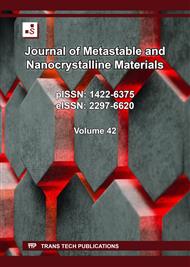[1]
S. Raghavan et al., "Ta2O5/Nb2O5 and Y2O3 Co-doped Zirconias for Thermal Barrier Coatings," J. Am. Ceram. Soc., vol. 87, no. 3, p.431–437, 2004.
Google Scholar
[2]
J. Kašpar and P. Fornasiero, "Nanostructured materials for advanced automotive de-pollution catalysts," J. Solid State Chem., vol. 171, no. 1–2, p.19–29, 2003.
DOI: 10.1016/S0022-4596(02)00141-X
Google Scholar
[3]
J. Nawrocki, C. J. Dunlap, P. W. Carr, and J. A. Blackwell, "New Materials for Biotechnology: Chromatographic Stationary Phases Based on Zirconia," Biotechnol. Prog., vol. 10, no. 6, p.561–573, 1994.
DOI: 10.1021/bp00030a001
Google Scholar
[4]
Y. Mizutani et al., "From rare earth doped zirconia to 1 kW solid oxide fuel cell system," J. Alloys Compd., vol. 408–412, p.518–524, 2006.
DOI: 10.1016/j.jallcom.2004.12.177
Google Scholar
[5]
R. P. Vitti, A. Catelan, M. Amaral, and R. R. Pacheco, Zirconium in dentistry. Elsevier Ltd, 2019.
DOI: 10.1016/B978-0-08-102476-8.00014-1
Google Scholar
[6]
H. Aldila and Triwikantoro, "Size Variations of Zircon Sand in Synthesis Zirconia Using Alkali Fusion - Coprecipitation Method," Proceeding Int. Conf. Res. Implement. Educ. Math. Sci. 2015, no. May, p.37–43, 2015, [Online]. Available: http://eprints.uny.ac.id/id/eprint/21037.
Google Scholar
[7]
A. M. Abdelkader, A. Daher, and E. El-Kashef, "Novel decomposition method for zircon," J. Alloys Compd., vol. 460, no. 1–2, p.577–580, 2008.
DOI: 10.1016/j.jallcom.2007.06.032
Google Scholar
[8]
M. Abdullah, T. Triwikantoro, C. Umamah, and H. J. Andi, "THE effect of ph and calcination temperature on the zro2 phase formation from natural zircon sand of kereng pangi," J. Neutrino, vol. 13, no. 2, p.39–48, 2021.
DOI: 10.18860/neu.v13i2.10507
Google Scholar
[9]
K. A. El Barawy, S. Z. El Tawil, and A. A. Francis, "Alkali fusion of zircon sand," Trans. Institutions Min. Metall. Sect. C Miner. Process. Extr. Metall., vol. 109, no. JAN./APR., p.49–56, 2000.
DOI: 10.1179/mpm.2000.109.1.49
Google Scholar
[10]
C. F. Burmeister and A. Kwade, "Process engineering with planetary ball millss", Chem. Soc. Rev., vol. 42, no. 18, p.7660–7667, 2013.
DOI: 10.1039/c3cs35455e
Google Scholar
[11]
H. X. Kho, S. Bae, S. Bae, B.-W. Kim, and J. S. Kim, "Planetary Ball Mill Process in Aspect of Milling Energy," J. Korean Powder Metall. Inst., vol. 21, no. 2, p.155–164, 2014.
DOI: 10.4150/kpmi.2014.21.2.155
Google Scholar
[12]
A. W. Handoko, D. Darsono, and D. Darmanto, "Aplikasi Metode Self Potential untuk Pemetaan Sebaran Lindi di Wilayah Tempat Pembuangan Akhir (TPA) Putri Cempo Surakarta", Indones. J. Appl. Phys., vol. 6, no. 01, p.13, 2016.
DOI: 10.13057/ijap.v6i01.1792
Google Scholar
[13]
A. Daulay, Andriayani, Marpongahtun, and S. Gea, "Extraction silica from rice husk with naoh leaching agent with temperature variation burning rice husk", Rasayan J. Chem., vol. 14, no. 3, p.2125–2128, 2021.
DOI: 10.31788/RJC.2021.1436351
Google Scholar
[14]
A. A. Madfa, F. A. Al-Sanabani, N. H. Al-Qudami, J. S. Al-Sanabani, and A. G. Amran, "Use of Zirconia in Dentistry: An Overview", Open Biomater. J., vol. 5, no. 1, p.1–7, 2014.
DOI: 10.2174/1876502501405010001
Google Scholar
[15]
J. Liu, J. Song, T. Qi, C. Zhang, and J. Qu, "Controlling the formation of Na2ZrSiO5 in alkali fusion process for zirconium oxychloride production", Adv. Powder Technol., vol. 27, no. 1, p.1–8, 2016.
DOI: 10.1016/j.apt.2015.08.005
Google Scholar
[16]
S. A. Hassanzadeh-Tabrizi, "Precise calculation of crystallite size of nanomaterials: A review" J. Alloys Compd., vol. 968, no. August, p.171914, 2023.
DOI: 10.1016/j.jallcom.2023.171914
Google Scholar
[17]
C. Suryanarayana, "Mechanical alloying and milling", Prog. Mater. Sci., vol. 46, no. 1–2, p.1–184, 2001, doi: 10.1016/S0079-6425(99)00010-9. 18] M. Rabiei, A. Palevicius, A. Monshi, S. Nasiri, A. Vilkauskas, and G. Janusas, "Comparing methods for calculating nano crystal size of natural hydroxyapatite using X-ray diffraction," Nanomaterials, vol. 10, no. 9, p.1–21, 2020.
DOI: 10.3390/nano10091627
Google Scholar
[19]
M. S. Hossain, M. Mahmud, M. Bin Mobarak, S. Sultana, M. A. A. Shaikh, and S. Ahmed, "New analytical models for precise calculation of crystallite size: application to synthetic hydroxyapatite and natural eggshell crystalline materials," Chem. Pap., vol. 76, no. 11, p.7245–7251, 2022.
DOI: 10.1007/s11696-022-02377-9
Google Scholar


